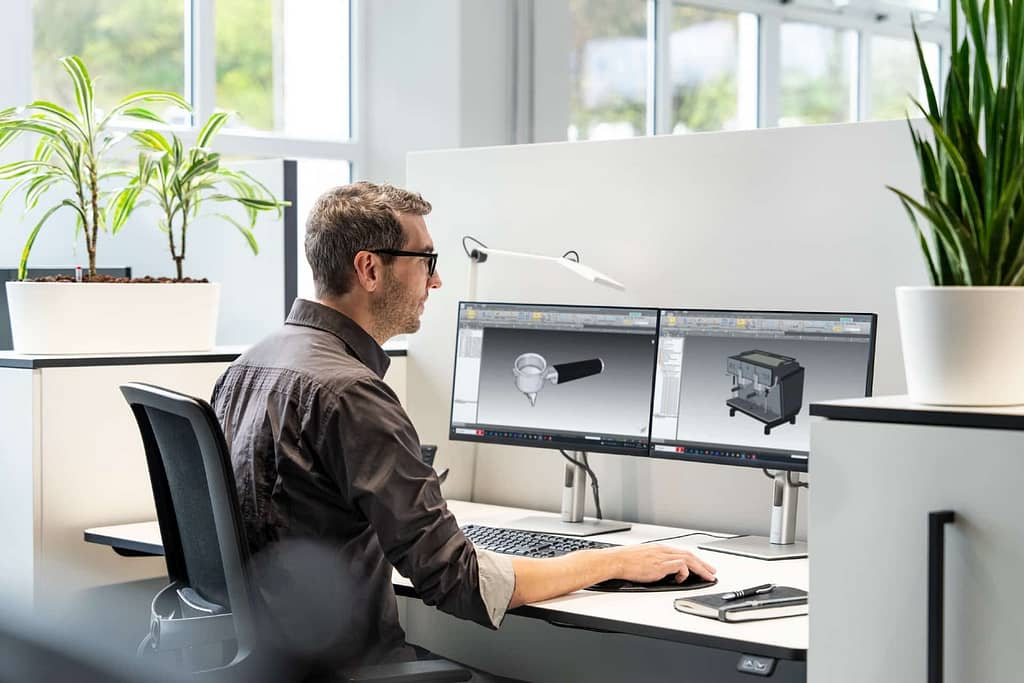[[{“value”:”

How will espresso be prepared in 10, 20, or 50 years? Axel Fähnle, Head of Marketing at WMF Professional Coffee Machines, explores the future of the craft.
With the continuous advancement of AI and automated technologies, it often feels like there’s been more innovation in the past 10 years than in the 100 years that came before them. Technical evolution is progressing at an ever-increasing pace, with all manner of industries taking advantage of the efficiency, consistency, and cost-reducing benefits – among others – of this emerging field of innovation.
Over the past decade, the coffee industry has embraced the progression of automated technology with open arms. For Axel Fähnle, Head of Marketing at WMF Professional Coffee Machines, the advancement of espresso machines has been truly remarkable.
“Today’s espresso machines offer greater customisation options, allowing baristas to fine-tune their brews to match specific preferences,” he says.
“This includes adjustable grind settings, customisable brew ratios, and the ability to handle various coffee types and styles. What’s more, some espresso machines now come with advanced automation capabilities, including programmable settings and touch-screen interfaces.”
Many of these features have been developed to enable precise control over brewing parameters, making it easier for baristas to achieve consistent results with less room for error. Fähnle highlights the WMF espresso NEXT semi-automatic portafilter machine as an example of the kind of premium equipment that’s changing the coffee preparation landscape for the better.
“The WMF espresso NEXT is particularly suited for specialty coffee environments where a lot of tweaking is required,” he says.
“Similar to a traditional portafilter, the machine gives the user maximum freedom when crafting individual creations. At the same time, its system technology in the form of Dynamic Coffee Assist helps baristas and professional caterers maintain a consistently high coffee quality.”
Fähnle and the team at WMF believe automation is reshaping the future of espresso machine technology and, in turn, making the barista’s role easier.
“Automated systems can streamline the coffee-making process, reducing the time and effort required from baristas. This is particularly beneficial in high-volume settings, where speed and efficiency are essential,” he says.
“When compared to traditional portafilter machines, the WMF Espresso NEXT reduces the manual preparation steps for a cappuccino by up to 40 per cent. This leaves more time for customer contact, leading to significantly shorter waiting times and thus higher sales.
“Meanwhile, customer satisfaction increases, not least thanks to a great show effect during preparation. The result is a genuine traditional coffee shop experience with the convenience and efficiency of the latest technology.”
For many business owners around the world, reducing energy consumption in line with global sustainability goals is a priority. With this in mind, the development of automated technologies has often prioritised energy-saving features.
“Automation can contribute to more sustainable practices by optimising resource use and reducing waste. For instance, precise dosing and brewing can minimise coffee and water waste,” he says.
“Thanks to its Auto Milk Dosing technology, the WMF espresso NEXT not only reduces spoilage but eliminates waste altogether. The system doses the exact amount of milk for each recipe directly into the jug, which can then be frothed immediately.”

Despite how far espresso machines have already come over the past 10 years, Fähnle believes there’s plenty more room for innovation in the industry.
“Features like temperature control, flow profiling, and soft infusion are now standard in commercial and prosumer espresso machines. We are also starting to see the use of AI, Internet of Things (IoT), and modular systems become more prominent in espresso machine technology,” he says.
“The integration of AI and IoT enable machines to learn user preferences, predict maintenance needs, and provide real-time data for better management.”
While some are sceptical of AI as it increasingly becomes a tool of everyday life, Fähnle is confident it will positively influence the future of espresso machine technology through productive maintenance and data-driven insights – among other benefits.
“Advanced telemetry systems can monitor the performance of espresso machines in real-time, predicting maintenance needs before issues arise. This will minimise downtime and extends the lifespan of the equipment,” he says.
“Automation can also provide valuable data insights on usage patterns, helping businesses optimise their operations. For example, understanding peak times for coffee sales can help in staffing and inventory management.”
So, how will baristas be pulling espresso shots in 10-, 20-, or 50-years’ time?
“Future espresso machines will likely incorporate more smart technology, such as app connectivity, and AI-driven features that can learn user preferences and optimise brewing parameters,” he says.
“Improved ergonomic designs will also make machines easier and more comfortable to use, reducing strain on baristas and enhancing the overall user experience.”
And it’s not just the technology inside the machines that will shift and evolve. According to Fähnle, design will continue to advance – and the future is minimal.
“As urban living spaces become smaller, there will be a demand for more compact and efficient espresso machines that can fit into limited spaces without compromising on performance,” he says.
“Design trends are moving towards sleek, minimalist aesthetics with clean lines and intuitive interfaces. This not only enhances the visual appeal but also simplifies the user experience.”
Finally, he believes the trend towards championing sustainable products will continue as the world works towards carbon neutrality by 2050.
“There will be a greater emphasis on using sustainable and recyclable materials in the construction of espresso machines,” he says. “This includes biodegradable plastics, recycled metals, and energy-efficient components.”
For more information, visit the WMF website.
This article was first published in the March/April 2025 edition of Global Coffee Report. Read more HERE.
The post The future of espresso preperation appeared first on Global Coffee Report.
“}]]


